
Jean Léopold Nicolas Frédéric, Baron Cuvier, known as Georges Cuvier, was a French naturalist and zoologist, sometimes referred to as the "founding father of paleontology". Cuvier was a major figure in natural sciences research in the early 19th century and was instrumental in establishing the fields of comparative anatomy and paleontology through his work in comparing living animals with fossils.

Georges-Louis Leclerc, Comte de Buffon was a French naturalist, mathematician, and cosmologist. He held the position of intendant (director) at the Jardin du Roi, now called the Jardin des plantes.

Bernard-Germain-Étienne de La Ville-sur-Illon, comte de Lacépède or La Cépède was a French naturalist and an active freemason. He is known for his contribution to the Comte de Buffon's great work, the Histoire Naturelle.

Henri Marie Ducrotay de Blainville was a French zoologist and anatomist.

Jean René Constant Quoy was a French naval surgeon, zoologist and anatomist.

Alcide Charles Victor Marie Dessalines d'Orbigny was a French naturalist who made major contributions in many areas, including zoology, palaeontology, geology, archaeology and anthropology.

Hyaenodon ("hyena-tooth") is an extinct genus of carnivorous placental mammals from extinct tribe Hyaenodontini within extinct subfamily Hyaenodontinae, that lived in Eurasia and North America from the middle Eocene, throughout the Oligocene, to the early Miocene.
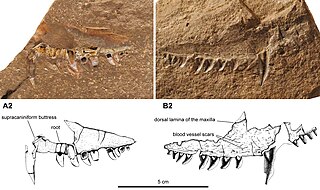
Neosaurus is an extinct genus of pelycosaur-grade synapsids from the Late Carboniferous-Early Permian of the Jura region of France. It is known only from a partial maxilla or upper jaw bone and an associated impression of the bone. The teardrop shape of the teeth in the jaw indicate that Neosaurus belongs to the family Sphenacodontidae, which includes the better-known Dimetrodon from the Southwestern United States. The maxilla was first attributed to an early diapsid reptile in 1857, and later a crocodylomorph in 1869, before finally being identified as a sphenacodont synapsid in 1899, a classification that still holds today.
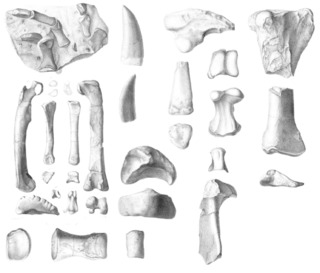
Erectopus is an extinct genus of basal allosauroid theropod from the Early Cretaceous La Penthiève Beds Formation of France and also possibly the Cernavodă Formation of southern Romania. The type species is E. superbus, which was initially known as a species of Megalosaurus.
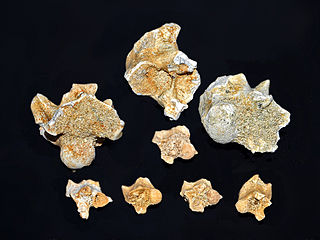
Palaeophis is an extinct genus of marine snake that is the type genus of the extinct snake family Palaeophiidae.

The rue Saint-Honoré is a street in the 1st arrondissement of Paris, France.

The Lesser Antillean macaw or Guadeloupe macaw is a hypothetical extinct species of macaw that is thought to have been endemic to the Lesser Antillean island region of Guadeloupe. In spite of the absence of conserved specimens, many details about the Lesser Antillean macaw are known from several contemporary accounts, and the bird is the subject of some illustrations. Austin Hobart Clark described the species on the basis of these accounts in 1905. Due to the lack of physical remains, and the possibility that sightings were of macaws from the South American mainland, doubts have been raised about the existence of this species. A phalanx bone from the island of Marie-Galante confirmed the existence of a similar-sized macaw inhabiting the region prior to the arrival of humans and was correlated with the Lesser Antillean macaw in 2015. Later that year, historical sources distinguishing between the red macaws of Guadeloupe and the scarlet macaw of the mainland were identified, further supporting its validity.
Paramiacis is an extinct genus of placental mammals from clade Carnivoraformes, that lived in Europe from middle to late Eocene. Species P. exilis and P. teilhardi were long believed to be a same species, with differences that were only represented as an example of sexual dimorphism.

Ikechosaurus is an extinct genus of choristodere reptile which existed in China and Mongolia during the Early Cretaceous. It contains the species Ikechosaurus sunailinae and Ikechosaurus gaoi. It belongs to the crocodilian-like clade Neochoristodera and was initially assigned to the Champsosauridae by Sigogneau-Russell (1981). Compared to other neochoristoderes, Ikechosaurus has a rather simple dentition, lacking the speciations seen in latter species. It also has parasphenoid palatal teeth, a feature not seen in any other choristodere.
Centrochelys atlantica is an extinct species of tortoise that lived in the Pleistocene. It was first recorded in the volcanic crater on Sal, Cape Verde. It was initially identified as similar to the extant Testudo calcarata. The species is no longer present anywhere in the Cape Verde islands. It has since been described as a new species, differentiated from C. sulcata by its smaller size and lesser robusticity. It does not seem there is any evidence this species came into contact with humans. Kehlmaier et al. (2021) identified the type material of this species as belonging to a specimen of the red-footed tortoise, making C. atlantica a junior synonym of the latter species and leaving the extinct tortoise known from fossils excavated on the Sal Island in the 1930s without a scientific name.
Lehmanosteus is an extinct monospecific genus of arthrodire placoderm fish, named after French paleontologist Jean-Pierre Lehman. The type species Lehmanosteus hyperboreus was described in 1984, and was found in Early Devonian strata of the Wood Bay Formation on the island of Spitsbergen, Svalbard in Norway.
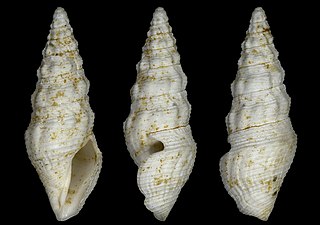
Crassispira margaritula is an extinct species of sea snail, a marine gastropod mollusc in the family Pseudomelatomidae, the turrids and allies. Fossils of this extinct marine species were found in Eocene strata of the Paris Basin, France.

Crassispira margaritula is an extinct species of sea snail, a marine gastropod mollusc in the family Pseudomelatomidae, the turrids and allies.
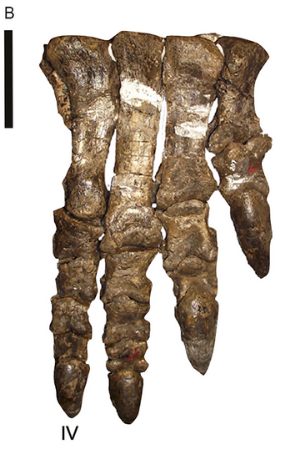
Kholumolumo, formerly "Kholumolumosaurus" or "Thotobolosaurus", is an extinct genus of massopodan sauropodomorph dinosaur, which was closely related to Sarahsaurus, from the lower Elliot Formation of Maphutseng, Lesotho. The type species, Kholumolumo ellenbergerorum was formally described in 2020.

Amphictis is an extinct genus of ailurid that existed from the Late Oligocene to the Middle Miocene with fossils found in Eurasia and North America with a total of nine described species. The interrelationships of the different species as well as their relationship to the other ailurids is not fully understood. Usually Amphictis is classified in the basal monotypic subfamily Amphictinae, but there is not certain as the genus could potentially be a paraphyletic with the Oligocene species A. borbonica being a potential sister taxon to the ancestor of the subfamily Ailurinae, while a Middle Miocene clade consisting of an anagenesis line from A. prolongata–to–A. wintershofensis–to–A. cuspida being closer to the ancestry of the now extinct Simocyoninae. This is due to the nature of their plesiomorphic nature of their anatomy.
















